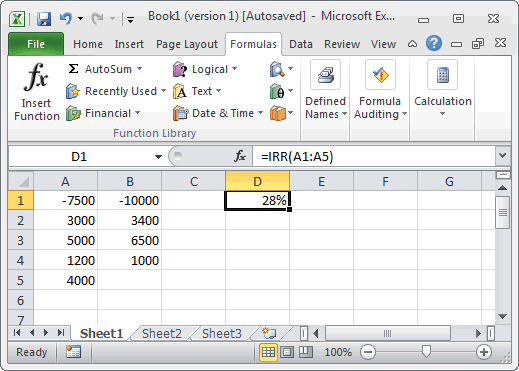MIRR Function
XIRR Function
The IRR Function on Excel provides quick key access in computing the internal rate of return for a series of cash flow periodically (i.e. Monthly, annually). There is a plethora of use with IRR function in Excel. IRR Excel Formula You can use the IRR function in Excel and you’ll need the following values: The initial investment (which would be negative cash flow) The cash flow value for each period. The IRR is used to make the net present value (NPV) of cash flows from a project/investment equal to zero. Generally, the easiest way to calculate IRR is using an Excel spreadsheet. The download below allows you to work out the internal rate of return of a series of cash flows so that the NPV is discounted to $0. We can use IRR (Internal Rate of Return) function in Excel to calculate return from a series of even spaced cash flows. IRR Example: For example, say you invest $10,000 in a savings bond and you get $500 per year for next 5 years and then you will get $11,000 back.
The Internal Rate of Return (IRR) provides an indication of the profitability of an investment and therefore, is commonly used in business, when choosing between investments.
This measurement uses a series of cash flows (an initial investment, along with the net income) over a number of periods, to calculate the compounded return, assuming the Net Present Value of the investment is zero.
The value of the IRR is calculated as the value of r that satisfies the following equation:
where the series of cash flows provide the values for Cn and N is the number of periods over which the returns have been made.
 For a full explanation of the IRR, see the Wikipedia Internal Rate of Return page
For a full explanation of the IRR, see the Wikipedia Internal Rate of Return page
Function Description
The Excel IRR function returns the Internal Rate of Return for a supplied series of periodic cash flows (i.e. an initial investment value and a series of net income values).
The syntax of the function is:
Where the arguments are as follows:
Irr To Work In Excel Formula
| values | - | An array of values (or a reference to a range of cells containing values) representing the series of cash flows (investment and net income values). This must include at least one negative value (representing outgoing payment) and at least one positive value (representing income). |
| [guess] | - | An initial guess at what the IRR might be. This is an optional argument, which, if omitted, takes on the default value of 0.1 (=10%). (Note: This is only a value for Excel to start off working with - Excel then uses an iterative procedure to converge to the IRR). |
Irr Function Example
In the spreadsheet below, an initial investment of $100 is shown in cell B1 and the net income over the next 5 years is shown in cells B2-B6.
The IRR function in cell C2 shows the calculation of the Internal Rate of Return after 3 years and the function in cell C4 shows the Internal Rate of Return after 5 years.
Irr Does Not Work In Excel
Formula:
|
|
Note that, in the above example, the initial investment is a negative value, as this is an outgoing payment, and the income payments are represented by positive values.
For further information and examples of the Excel Irr function, see the Microsoft Office website.
:max_bytes(150000):strip_icc()/04-how-to-calculate-IRR-in-Excel-c495b58d8c8e4e2aa217ea8f2a2219c3.jpg)
Irr Function Error
If you get an error from the Excel Irr function, this is likely to be the #NUM! error:
How To Irr In Excel
| #NUM! | - | Occurs if either:
|
Irr In Excel Example
Return to the List of All Built-In Excel Functions